Abwaoberyl
On this page, you find all documents, package deals, and flashcards offered by seller abwaoberyl.
- 127
- 0
- 0
Community
- Followers
- Following
127 items
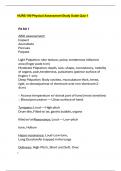
NURS 190 Physical Assessment Study Guide Quiz 1.
NURS 190 Physical Assessment Study Guide Quiz 1 PA SG 1 ABD assessment: Inspect Auscultate Percuss Palpate Light Palpation: skin texture, pulse, tenderness inflamed area (finger pads 1cm) Moderate Palpation: depth, size, shape, consistency, mobility of organs, pain, tenderness, pulsations (palmar surface of fingers 1-cm) Deep Palpation: Body cavities, musculature thick, tense, rigid, or obese (palmar of dominant over non-dominant 24cm) • Access temperature w/ dorsal part of hand (most sensi...
- Exam (elaborations)
- • 8 pages •
NURS 190 Physical Assessment Study Guide Quiz 1 PA SG 1 ABD assessment: Inspect Auscultate Percuss Palpate Light Palpation: skin texture, pulse, tenderness inflamed area (finger pads 1cm) Moderate Palpation: depth, size, shape, consistency, mobility of organs, pain, tenderness, pulsations (palmar surface of fingers 1-cm) Deep Palpation: Body cavities, musculature thick, tense, rigid, or obese (palmar of dominant over non-dominant 24cm) • Access temperature w/ dorsal part of hand (most sensi...

NURS 190 Physical Assessment Study Guide Quiz 2.
NURS 190 Physical Assessment Study Guide Quiz 2 Circumoral Cyanosis: EARLY sign for hypoxia / respiratory distress Late Hypoxia Sign • Barrel Chest & Clubbing Tachypnea: Rapid, shallow respirations >24 Hyperventilation: Rapid, deep respirations >24 Bradypnea: slow, regular <10 Hypoventilation: Irregular, shallow <10 Cheyne Stokes Periods of deep breathing & apnea alternating, regular pattern Asthma • Wheezing, Increased RR • Bronchiole Inflammation, mucus, phlegm, bronch...
- Exam (elaborations)
- • 3 pages •
NURS 190 Physical Assessment Study Guide Quiz 2 Circumoral Cyanosis: EARLY sign for hypoxia / respiratory distress Late Hypoxia Sign • Barrel Chest & Clubbing Tachypnea: Rapid, shallow respirations >24 Hyperventilation: Rapid, deep respirations >24 Bradypnea: slow, regular <10 Hypoventilation: Irregular, shallow <10 Cheyne Stokes Periods of deep breathing & apnea alternating, regular pattern Asthma • Wheezing, Increased RR • Bronchiole Inflammation, mucus, phlegm, bronch...
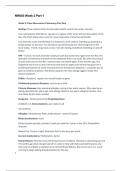
NR603 Week 2 Part 1
NR603 Week 2 Part 1 Week 2: Case Discussion: Pulmonary Part One Setting: A free medical clinic that provides health care for the under-insured. Your next patient, Michelle G., age 40, is a regular of the clinic and the last patient of the day. The chart states she is here for recent episodes of shortness of breath. You enter the room and Michelle G is dressed in work clothes, standing up looking at a health poster on the wall. You introduce yourself and ask her what brings her to the clinic to...
- Exam (elaborations)
- • 6 pages •
NR603 Week 2 Part 1 Week 2: Case Discussion: Pulmonary Part One Setting: A free medical clinic that provides health care for the under-insured. Your next patient, Michelle G., age 40, is a regular of the clinic and the last patient of the day. The chart states she is here for recent episodes of shortness of breath. You enter the room and Michelle G is dressed in work clothes, standing up looking at a health poster on the wall. You introduce yourself and ask her what brings her to the clinic to...
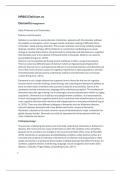
NR603 Delirium vs Dementia Assignment.
NR603 Delirium vs Dementia Assignment Hello Professor and Classmates, Delirium and Dementia Delirium is consider an acute disorder of attention, patients with this disorder will have the inability or disruption, which causes mental confusion making it difficult to think, remember, sleep and pay attention. This is seen relatively commonly in elderly people (Kukreja, Günther, & Popp, 2015). Delirium is a syndrome manifesting as an acute change in mental status that is characterized by inattentio...
- Exam (elaborations)
- • 4 pages •
NR603 Delirium vs Dementia Assignment Hello Professor and Classmates, Delirium and Dementia Delirium is consider an acute disorder of attention, patients with this disorder will have the inability or disruption, which causes mental confusion making it difficult to think, remember, sleep and pay attention. This is seen relatively commonly in elderly people (Kukreja, Günther, & Popp, 2015). Delirium is a syndrome manifesting as an acute change in mental status that is characterized by inattentio...
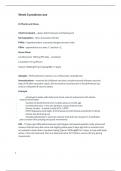
NR603 Week 5 Part 1 Predictor
NR603 Week 5 Part 1 Predictor.Week 5 predictor ass Dr Martin and Class, Chief Complaint – upper abdominal pain and feeling sick Demographics - 40 yo Caucasian female PMHx – Hypothyroidism, seasonal allergies (worse in fall) PSHx – appendicitis as a teen, C-section x 2, Home Meds Levothyroxine 100mcg PO daily - compliant Loratadine 10 mg PO prn Tylenol 1000mg PO prn (taking BID x 7 days) Allergies - PCN (unknown reaction, as a child), bees, strawberries Immunizations – received all chi...
- Exam (elaborations)
- • 8 pages •
NR603 Week 5 Part 1 Predictor.Week 5 predictor ass Dr Martin and Class, Chief Complaint – upper abdominal pain and feeling sick Demographics - 40 yo Caucasian female PMHx – Hypothyroidism, seasonal allergies (worse in fall) PSHx – appendicitis as a teen, C-section x 2, Home Meds Levothyroxine 100mcg PO daily - compliant Loratadine 10 mg PO prn Tylenol 1000mg PO prn (taking BID x 7 days) Allergies - PCN (unknown reaction, as a child), bees, strawberries Immunizations – received all chi...
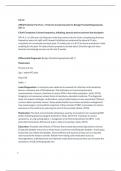
NR603 Week 5 Part 2 APEA Predictor.
NR603 Week 5 Part 2 APEA Predictor. Part 2 APEA Predictor Part Two – First line treatment plan for Benign Prostate Hyperplasia (40.1) Chief Complaint: Urinary frequency, dribbling, dysuria and occasional low back pain HPI: A.C. is a 69-year-old Hispanic male that comes into the clinic complaining of urinary frequency worse at night with frequent dribbling accompanied by dysuria. Pt also complains of occasional low back pain. Pt states pain is a 6/10 at worse and doesn’t take anything for ...
- Exam (elaborations)
- • 3 pages •
NR603 Week 5 Part 2 APEA Predictor. Part 2 APEA Predictor Part Two – First line treatment plan for Benign Prostate Hyperplasia (40.1) Chief Complaint: Urinary frequency, dribbling, dysuria and occasional low back pain HPI: A.C. is a 69-year-old Hispanic male that comes into the clinic complaining of urinary frequency worse at night with frequent dribbling accompanied by dysuria. Pt also complains of occasional low back pain. Pt states pain is a 6/10 at worse and doesn’t take anything for ...
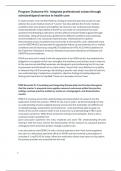
NR603 Week 8 Reflection.
Program Outcome #4: Integrate professional values through scholarship and service in health care In week number 3 we met the PO#4 by creating a treatment plan that would not only address the acute medical needs of “Lorene” but also address the chronic medical conditions that were present and additive risk factors to her cardiovascular disease. Understanding the responsibility of the NP as a provider to comprehend how each symptom/result/finding is relevant to and has effects on whole health...
- Exam (elaborations)
- • 3 pages •
Program Outcome #4: Integrate professional values through scholarship and service in health care In week number 3 we met the PO#4 by creating a treatment plan that would not only address the acute medical needs of “Lorene” but also address the chronic medical conditions that were present and additive risk factors to her cardiovascular disease. Understanding the responsibility of the NP as a provider to comprehend how each symptom/result/finding is relevant to and has effects on whole health...
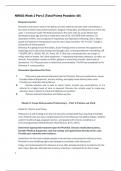
NR603 Week 2 Part 2
NR603 Week 2 Part 2 (Total Points Possible: 40) Requirements: Michelle continues to work in the bakery and her asthma has been well controlled on a low-dose inhaled corticosteroid inhaler, Singular 10mg daily, and Albuterol prn which she uses 1-2 times per week. Michelle presents to the clinic with an acute illness that developed 2 days ago and has a respiratory rate of 24, mild SOB with exertion, O2 saturation of 94%, and complaint of inspiratory and expiratory wheezing. She is able to speak a...
- Exam (elaborations)
- • 3 pages •
NR603 Week 2 Part 2 (Total Points Possible: 40) Requirements: Michelle continues to work in the bakery and her asthma has been well controlled on a low-dose inhaled corticosteroid inhaler, Singular 10mg daily, and Albuterol prn which she uses 1-2 times per week. Michelle presents to the clinic with an acute illness that developed 2 days ago and has a respiratory rate of 24, mild SOB with exertion, O2 saturation of 94%, and complaint of inspiratory and expiratory wheezing. She is able to speak a...
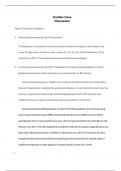
NR603 Week 3 Case Discussion Cardiovascular
Cardiac Case Discussion Week 3 Discussion Questions: 1. What Leads Demonstrate the ST Depression? ST depression is indicative of acute myocardial ischema and hypoxia. Heart failure may cause ST depression and this is seen in leads V2, V3, V4, V5, and V6 (Klabunde, 2016; Harhash et al 2017). These depressions are horizontal or downsloping. 2. Is Lorene Hypertensive per ACA 2017 Guidelines? Compare the ACA guidelines to JNC 8 guidelines and discuss what treatment you recommend for her BP and wh...
- Exam (elaborations)
- • 10 pages •
Cardiac Case Discussion Week 3 Discussion Questions: 1. What Leads Demonstrate the ST Depression? ST depression is indicative of acute myocardial ischema and hypoxia. Heart failure may cause ST depression and this is seen in leads V2, V3, V4, V5, and V6 (Klabunde, 2016; Harhash et al 2017). These depressions are horizontal or downsloping. 2. Is Lorene Hypertensive per ACA 2017 Guidelines? Compare the ACA guidelines to JNC 8 guidelines and discuss what treatment you recommend for her BP and wh...
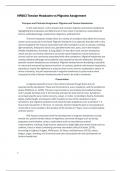
NR603 Tension Headache vs Migraine Assignment.
NR603 Tension Headache vs Migraine Assignment Compare and Contrast Assignment: Migraine and Tension Headaches In this submission, I will compare and contrast migraine and tension headaches highlighting the similarities and differences in their onset of symptoms, associated risk factors, pathophysiology, assessment, diagnosis, and treatment. The term headache widely refers to a variety of conditions that affect the nervous system and cause pain in the head. Migraine headache is an episodic di...
- Exam (elaborations)
- • 5 pages •
NR603 Tension Headache vs Migraine Assignment Compare and Contrast Assignment: Migraine and Tension Headaches In this submission, I will compare and contrast migraine and tension headaches highlighting the similarities and differences in their onset of symptoms, associated risk factors, pathophysiology, assessment, diagnosis, and treatment. The term headache widely refers to a variety of conditions that affect the nervous system and cause pain in the head. Migraine headache is an episodic di...
